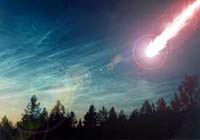Tunguska event an actual UFO crash site
In recent history, the famous Tunguska event stands out as one of the rare large-scale demonstrations that a full doomsday event is a real possibility for the human race.

Back during the Soviet Union times a science-fiction writer Aleksandr Kazantsev suggested that the event was a result of a UFO explosion rather than a meteorite crash. However, the Soviet scientists rejected the theory and prohibited the author from continuing any further research in that area, Ufolog reports.
Since 1994 the theory has been revived after the Tunguska Spatial Phenomenon Foundation in Krasnoyarsk, made up of some 15 enthusiasts, among them geologists, chemists, physicists and mineralogists have been organising regular expeditions to the area.
Wikipedia informs that the Tunguska event was an explosion that occurred near the Podkamennaya Tunguska River in what is now Evenk Autonomous Okrug, in the early morning hours of June 30, 1908.
The energy of the blast, which was assumed to have been caused a meteorite or a comet, was later estimated to be between 10 and 15 megatons of TNT, which would be equivalent to Castle Bravo, the most powerful nuclear bomb ever detonated by the U.S.
The blast felled an estimated 60 million trees causing damage 400 miles away, and was heard even further. Even the heat that came out from the explosion was felt hundreds of miles away. For several nights all over northern Europe, the sky glowed enough to light the street of London.
The 1927 investigation expedition could not locate any bits of meteorite which puzzled the researchers looking for evidence. Another puzzle for the expedition was the way the tress were felled in an outward motion and that in the center trees were still standing, although all their bark and branches have been destroyed.
Fascination with the Siberian mystery has not diminished since, and many scientists to this day are struggling to figure out the real cause of the destruction.
Still only Kazantsev’s unusual theory is capable of shedding some light on the multitude of questions about the Tunguska event. Perhaps the famous meteorite’s site really was a site of a spaceship crash?
UFO Evidence reports that after the Second World War and the bombing of Hiroshima and Nagasaki, photos of the cities were compared with aerial photos of the Tunguska blast, and they were stunningly similar. Many of the witnesses to the original crash spoke of seeing and oval-shaped mass moving across the sky, as well as seeing the object change course, and of having a very low speed.
The nuclear-powered UFO hypothesis was adopted by TV drama critics Thomas Atkins and John Baxter in their book The Fire Came By. The 1998 television series The Secret KGB UFO Files referred to the Tunguska event as "the Russian Roswell" and claimed that crashed UFO debris had been recovered from the site.
Natalia Vysotskaya
Pravda.ru
Subscribe to Pravda.Ru Telegram channel, Facebook, RSS!





